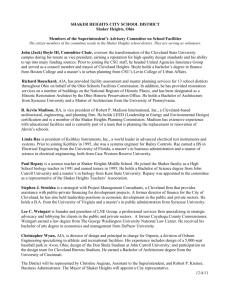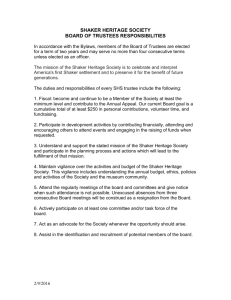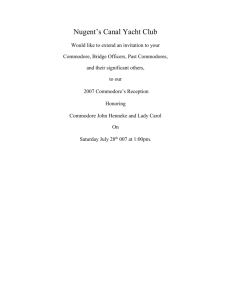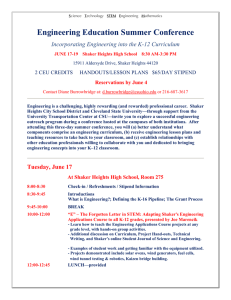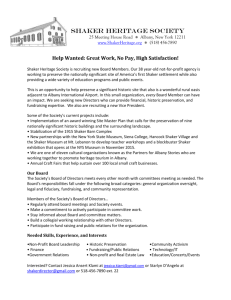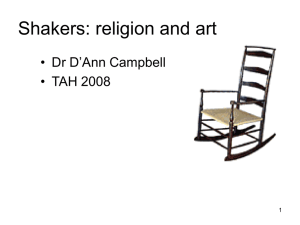Amanda Ahrens AP World Experience
advertisement
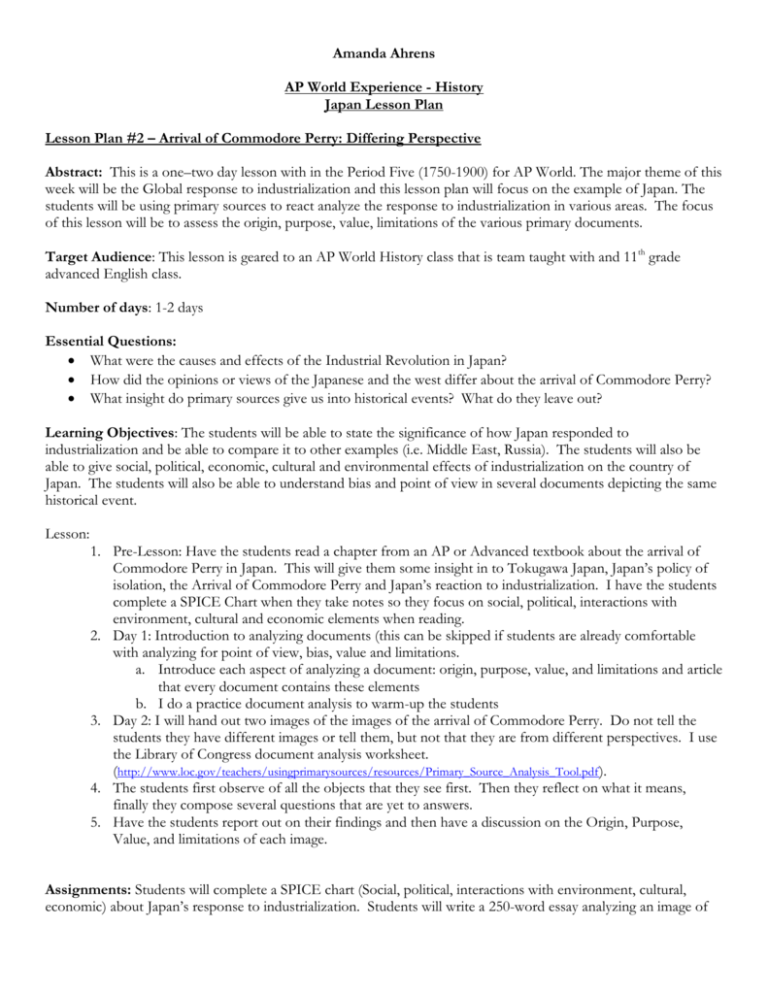
Amanda Ahrens AP World Experience - History Japan Lesson Plan Lesson Plan #2 – Arrival of Commodore Perry: Differing Perspective Abstract: This is a one–two day lesson with in the Period Five (1750-1900) for AP World. The major theme of this week will be the Global response to industrialization and this lesson plan will focus on the example of Japan. The students will be using primary sources to react analyze the response to industrialization in various areas. The focus of this lesson will be to assess the origin, purpose, value, limitations of the various primary documents. Target Audience: This lesson is geared to an AP World History class that is team taught with and 11th grade advanced English class. Number of days: 1-2 days Essential Questions: What were the causes and effects of the Industrial Revolution in Japan? How did the opinions or views of the Japanese and the west differ about the arrival of Commodore Perry? What insight do primary sources give us into historical events? What do they leave out? Learning Objectives: The students will be able to state the significance of how Japan responded to industrialization and be able to compare it to other examples (i.e. Middle East, Russia). The students will also be able to give social, political, economic, cultural and environmental effects of industrialization on the country of Japan. The students will also be able to understand bias and point of view in several documents depicting the same historical event. Lesson: 1. Pre-Lesson: Have the students read a chapter from an AP or Advanced textbook about the arrival of Commodore Perry in Japan. This will give them some insight in to Tokugawa Japan, Japan’s policy of isolation, the Arrival of Commodore Perry and Japan’s reaction to industrialization. I have the students complete a SPICE Chart when they take notes so they focus on social, political, interactions with environment, cultural and economic elements when reading. 2. Day 1: Introduction to analyzing documents (this can be skipped if students are already comfortable with analyzing for point of view, bias, value and limitations. a. Introduce each aspect of analyzing a document: origin, purpose, value, and limitations and article that every document contains these elements b. I do a practice document analysis to warm-up the students 3. Day 2: I will hand out two images of the images of the arrival of Commodore Perry. Do not tell the students they have different images or tell them, but not that they are from different perspectives. I use the Library of Congress document analysis worksheet. (http://www.loc.gov/teachers/usingprimarysources/resources/Primary_Source_Analysis_Tool.pdf ). 4. The students first observe of all the objects that they see first. Then they reflect on what it means, finally they compose several questions that are yet to answers. 5. Have the students report out on their findings and then have a discussion on the Origin, Purpose, Value, and limitations of each image. Assignments: Students will complete a SPICE chart (Social, political, interactions with environment, cultural, economic) about Japan’s response to industrialization. Students will write a 250-word essay analyzing an image of Commodore Perry’s landing in Japan or comparing the two images. Students will make note of Point of View, tone and context of the image. Ohio Academic Content Standards: Modern World History 9. Industrialization had social, political and economic effects on Western Europe and the world. 10. Imperial expansion had political, economic and social roots. Resources: Handouts Guide to OPVL (Origin, Purpose, Value and Limitations) of Primary Source documents. SPICE Chart Books AP World Textbook, Earth and It’s People Articles “The Industrial Revolution Outside the West” by Peter Sterns (For comparison of how different regions reacted to the spread of industrialization) Images Japanese Prespective: American Navy Commodore Matthew Perry arrives in Japan, August 7, 1853, Woodblock Print West (American) Perspective: “Landing at Yokohama” by William Heine (1825-1885) SPICE CHART Analysis AP THEME Social: Can include socioeconomic groups; class/caste; racial & ethnic constructions; family & gender roles & relations; systems of unfree labor (indenture, slavery, etc.), associations (guilds, etc.); religious groups Political: Political structures and forms of governance, legal system, political interest groups/factions, power bases; changes and functions of states; rise of nation states, nationalism; attitudes toward states; relationship between individuals and states; revolts & revolutions; regional, trans-regional, and global structures & organizations Interaction between people and environment: Human impact on environment, environment’s impact on culture; natural, human, technological resources; demography, patterns of movement and settlement, disease, pop. growth, decline; technology and innovation, rise of agriculture & manufacturing, postmodern technology (computers, internet, cell phones, etc. Cultural & Intellectual: The arts, literature, philosophy, architecture; mathematics & science; belief systems, religions, ethical and moral values, ideologies Economic: Creation, expansion, & interaction of economic systems; natural, human, technological, & capital resources; agricultural & pastoral production; trade & commerce; labor systems; technology and innovation; industrialization; capitalism & socialism CULTURE/CIVILIZATION: OPVL Analysis Tips In analyzing a document for OPVL, consider the questions below and make reference to specific historical events or trends that illustrate your answers. Origin: When was the document created? Who created it? Where did it first appear? Is it a primary or secondary source? What was the historical context in which it was created? Purpose: Why did the author create the document? Who is the intended audience? Value and limitations: What information was available to the author that might not be available elsewhere? What important information was not available to the author? (Consider when the document was created.) Did the author get information from a reliable source? Does the author have reasons to emphasize certain facts over others to a particular audience? Might the author present the story differently to different audience? What specific information might the author have chosen to leave out? Does the author concede a certain point that it is inconvenient for him/her to admit to? How might the historical context in which the document was created influence our interpretation? Practice Document Analysis SITUATION DESCRIPTION: The annual Shaker Raiders versus Cleveland Heights Tigers football game was played Friday night. Due to family commitments I was unable to attend the game. The game was decided when Andrew Taylor-Shaut caught a touchdown pass on the last play of the 4th quarter giving Shaker a 14-10 victory. Monday morning when I arrived at school "everyone" was talking about the "catch" and the victory. What I want to know is what REALLY happened and just how great of a play this catch actually was. Throughout the day I spoke to the following people in an attempt to obtain the truth. As I review each source I must constantly ask myself "what is the validity of each person's comment and what is their particular expertise in the area of high school football. DOCUMENTS Clifton Turner, Newspaper Reporter, Sun Press The annual Shaker -- Cleveland Heights football game ended in dramatic fashion when Andrew Taylor-Shaut caught the game winning touchdown pass as time expired. Taylor-Shaut made a leaping catch and landed safely in the endzone capping an improbable come from behind win for the Tigers. (note: most high school game results are phoned into the newspaper sports desk) Andrew Taylor-Shaut, Shaker Wide Receiver who caught the winning pass Did you see that catch?! I mean it was great! Man I knew I had it! That D-back was nothing! I ran right by him and just reached out and pulled it in. Focus, real focus!! We're number 1!! Deandre’ Smith, Offensive Coach, Shaker High School Great catch! Unbelievable! Andrew has heart and no quit in him. When it mattered I knew he would come through. He's tough, a real gamer! I had the team focused. We were ready to play. Never a doubt! Savanna McCartthy, Shaker Cheerleader Captain It was a totally awesome catch! We won the game and, like totally disgraced that other team. I knew we would win after our half-time show, and we did! We rock! Go Shaker! Those Cleveland Heights guys had no chance. And you should have seen those Cleveland Heights girls! Their cheers were sloppy and screechy. No wonder we won!!! We're number 1!! Ms. Shrestha, Shaker teacher who attended the game to watch her students play Shaker played real hard. The boys were great. It was a great catch that won a hard fought game. The noise in the stands after the game was unbelievable. Everyone was hugging each other and screaming. Seth Beal, Defensive back who covered Andrew, Cleveland Heights High School We were robbed. That guy never caught the ball, he was lying there on the ground and the ball fell in his hands. He pushed me and the ref never saw nothing. Shaker is nothing but a bunch of cheats! Ifeolu Claytor, Defensive Coach, Cleveland Heights High School What can I say? Seth played him real tight. Shaker ended up on the ground with the ball and the touchdown. Some nights you just aren't lucky, some you are. Document Details (Origin, Purpose, Value, Limitations) POINT OF VIEW (Why was THIS person producing THIS piece of information at THIS Gala Hughley, Football Referee, excerpt from his game report to the Ohio High School Activities Association It was a clean and simple catch resulting in a touchdown. No penalty was involved. Leon Kimmelfield, Assistant Football Coach, University of Nebraska. Excerpt from his scouting report. #83 Andrew Taylor-Shaut, Senior. Position: Wide Receiver. Height: 5'6". Weight: 155. Comment: Has poor hands and only average speed. time or in this manner?) 1. 2. 3. 4. 5. 6. 7. 8. 9.
